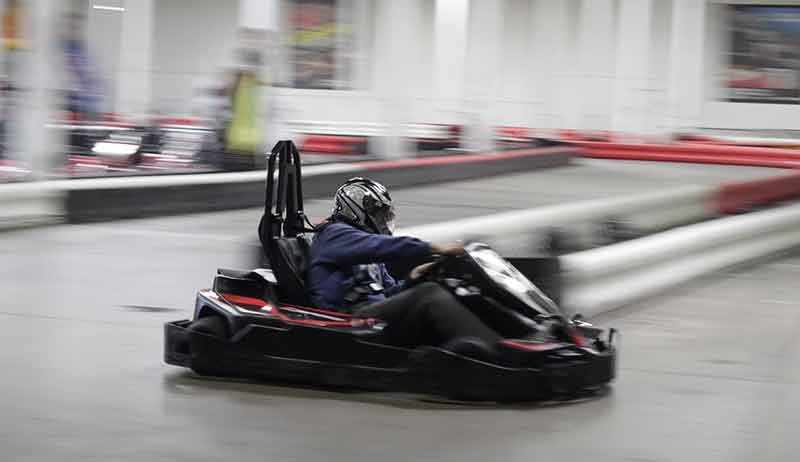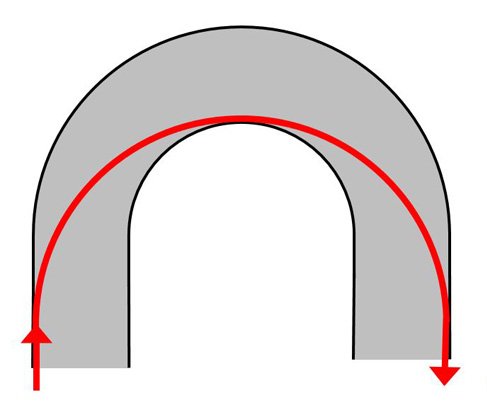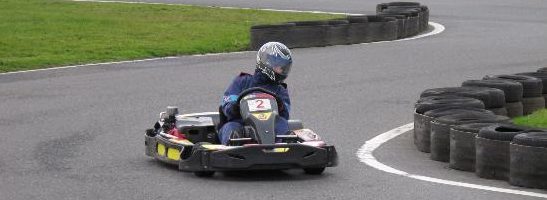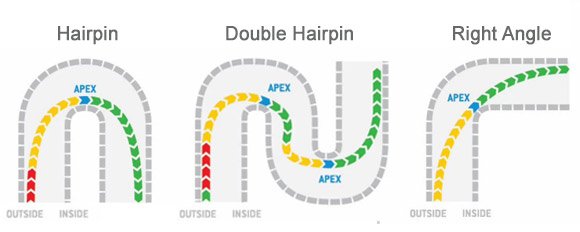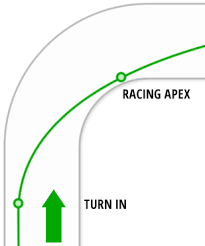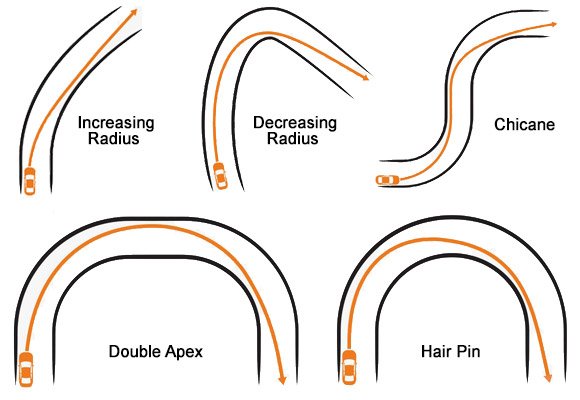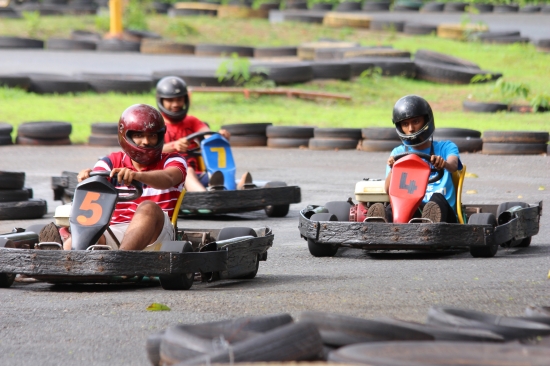Advanced Go Kart Cornering Techniques
Races aren’t won in the corners, but they are often lost. The art of fast corners can be mastered with consistent braking techniques and throttle discipline. Sure, Go Kart Cornering sounds like it would be pretty simple. Most amateurs would tell you “Put the peddle to the metal and get off that brake”!! There’s more to it and everyone could use a few pointers on how to drive the perfect line. So here we will discuss how to do go kart cornering like a pro-kart driver.
What’s “the line” you might be wondering….let’s start there.
What is the Racing Line?
The racing line is the route a kart racer follows in order to move through the corner in the quickest possible manner. Utilizing all of the available space on the track, drivers of a go kart can move in a straight line and then increase speed before reaching the traction limits on the tires. More info here.
As we move through this go kart cornering tutorial, you will see diagrams of the racing line overlayed on various types of turns to show you the best path to each corner effectively take.
The Basic Racing Go Kart Cornering Strategy
Getting fast depends totally on your ability to be smooth! Any sudden movements on the brake, throttle or steering wheel cause resistance and slows you down through the corners. It takes practice and seat time in your kart. But the smoother you get, the faster you’ll be.
Here is the basic approach to a corner:
- Place your kart on the outside of the track, staying on the gas.
- Ease onto the brake firmly staying in a straight line (this is called threshold braking)
- Come off the break and ease back onto the throttle as you start your turn in
- Aim for the inside edge of the track on entry
- Maintain consistent power through mid-turn
- You should be closest to the inside edge through mid-turn
- Ease on the throttle and use all of the track on exit
The above depiction is pretty basic and it assumes that all turns can be approached the same. Let’s move into a more advanced discussion about corners and braking which should fit into your overall go kart racing strategy.
Tips for Advanced Braking Techniques Pre- Corner
A good go kart cornering tips starts with a good braking technique that gets the go kart under control. First, we will discuss how to properly brake into a corner and then move into how to approach and speed through multiple types of turns. A good go kart cornering technique should begin with the brake….
How to Brake into a Corner
There are three phases of braking:
Phase 1: (Start of braking zone) When you apply the brake, be fast onto the pedal, but be careful not to apply maximum pressure. Your aim to is to apply enough pressure without crossing the grip threshold of your tires and losing traction.
When you apply the correct amount of brake, the front end of your go kart dips forward and you will be able to assess how your front tires are handling the pressure.
Phase 2: Interpret the go karts reaction to the brake pressure. Ease up or apply more brake pressure based on your front tire’s ability to keep a grip with the track. If it feels like the back end of the kart is getting loose, ease up on the brake pressure.
Phase 3: (End of braking zone) Ease pressure off the brake and transition from maximum pressure smoothly down to zero brake pressure. This will increase your available traction.
After phase 3 is over, you are at the end of the braking zone. Ease on the brake completely on the throttle or feather the throttle to transition to a smooth corner entry.
1. Pro Tip: Releasing the brake quickly reduces grip which is the last thing you want to do on a corner turn-in.
2. Pro Tip: Find landmarks on or off the race track that will indicate to you when to brake. Practice braking at these intervals and you will start being consistent with your braking and your lap times.
Once you understand the 3 phases of braking you can begin to apply 3 advanced braking techniques through the phases.
Threshold Braking
Threshold braking is commonly referred to as straight-line braking. It is the most straight forward method and is the best technique for beginner karters. The advantage of threshold braking is that you can get your go kart under control before you start the turn-in.
To threshold brake correctly, apply the brakes with as much force possible keeping your front tires pointed straight and without braking the limit of your tires traction. You want to identify the exact point in your brake pedal that is the balance between too much pressure and not enough. Once you know that point you can brake later than your opponents and still brake efficiently into the corner.
The only way to find the sweet spot in your brake pedal is to practice. Once you know what it feels like when your tires are braking traction with the track, you will learn to stop your braking pressure right before you reach that point. If your kart feels on the edge of its grip limits, ease your foot back off the brake, but keep enough pressure to stay within your grip threshold.
3. Pro Tip: Threshold braking is super effective in situations where there are long straights with hair pins at the ends of them.
Cadence Braking
This braking method works well in tandem with threshold braking. It’s for more advanced racers, because it allows you to steer while you brake.
Cadence braking is executed by pumping the brake pedal repeatedly. The technique makes your brakes lock and unlock. The effect is that you can simultaneously steer while slowing down the go kart. Cadence braking is NOT as effective as threshold braking, because it increases the length of your braking zone. When you use it in conjunction with the threshold technique it can make up for mistakes if you started threshold braking too late in the zone.
4. Pro Tip: Cadence braking is most effective in situations like accident avoidance or last second turn in corrections.
Trail Braking
Trail braking allows you to rotate the rear end of your go kart into a corner. The technique works really well when you are past the standard braking point and close to the corner entry. It is the key braking technique to master for a fast and efficient turn entry, but it’s also the most difficult and dangerous.
To trail brake successfully you apply brake pressure just as you would in threshold braking, except you don’t want to reach the braking threshold. Your goal is to brake at 80% or the threshold and then start your corner entry and apply the remaining 20% of the threshold as you turn in.
It is a pro technique that is difficult to master because you have to brake late and be aggressive. Trail braking is extremely effective because you can carry your speed and momentum from the straight-away into the turn-in. When you speed into a turn and brake late you shift the weight of the kart to the front which increases traction on your front tires and reduces traction on the rear. While it will cause rental karts to over-steer on the corner entry, it results in you steering less on entry and exit.
Essentially the less steering you are doing, the faster you will be, however mistakes while trying to trail brake will slide you right off the track because you will have too much speed on the turn-in. Trail braking requires practice, a good feel for your brake pedal, and excellent familiarity with the braking zones on the track.
5. Pro Tip: If you brake to late while trail braking your slip angle will cause the rear tires to slide and break traction with the track. This will reduce your lap times when performed incorrectly.
6. Pro Tip: Trail braking does not equate to a large time savings per corner. If it is its consistently applied through disciplined use it will significantly lower your lap time at times.
7. Pro Tip: The most important thing to remember about driving your go kart is to never, ever use both the throttle and brake at the same time. Not only does it just feel wrong, but it puts a huge amount of pressure on the clutch. You might cause the clutch to slip in some cases, generally, you will just damage it, making it less efficient, and slowing you down.
Tips for Advanced Go Kart Cornering Techniques
With an understanding of braking techniques we now know how to slow down the kart for the corner…its time to start perfecting the turns. Staying smooth through the corners, and maintaining your speed through them is crucial. You’ll find that until you get smooth at your go kart cornering, you’ll be coming out slower than those who are and it will frustrate you!
The key to corners is knowing the parts of the corner and how to approach different tracks and corner types.
Three Parts of a Corner: Entry, Apex, and Exit
Despite corners having different angles, shapes, and names they can all be broken down into 3 distinct parts. The Entry (the turn-in), the Apex (the midpoint), the Exit (the turn-out). Each part of the turn requires different of driving style and inputs. Understanding what you should be doing through each of the corner parts will help you master smooth and efficient corners.
Corner Entry
Your approach to a corner should be a wide approach in a straight line and fully compressed on the throttle. Then apply your braking technique on the straightway through the braking zone. For most corners, your turn-in begins when you see the apex up ahead.
The Apex and When to Use Which Racing Strategy
The apex is the middle of the corner and is a great safe approach.
There are actually three types of apexes; early apex, mid apex, and late apex.
The mid apex allows you to carry the highest amount of average speed into a turn, the early apex is used to maintain control when trying to out-brake an opponent into a corner, and the late apex is used to get the most amount of speed on your turn exit.
While the mid apex is great for standard corners, it is not the fastest way around a corner…
Use the Late Apex for Fast Corners
For the late apex, the corner approach is the same as a mid apex wide and will all of your braking complete prior to turn-in. The key for the late apex is that you turn in late which changes your slip angle and allows you to catch the inside of the turn just past the mid apex.
The late apex results in higher exit speed because you can get your front wheels straightened faster and start applying heavier throttle.
8. Pro Tip: Using the late apex on corners before long straight aways is the best way to achieve maximum speed on the straights and will result in faster lap times
Use the Mid Apex When you Need Extra Grip
If you are approaching a turn and your speed is maximized a mid-apex approach will minimize the corner radius which reduces cornering force and provides some grip for maintaining your speed.
Use the Early Apex for Overtaking your Opponent
The early apex is the point prior to the mid point can also be advantageous in certain situations, particularly in overtaking. The key is to out brake early on your opponent, if you already have the inside line, and then block them on the turn exit. The downside to the early apex is it results in the slowest corner exit speed. In the case of the early apex, it is best to use a threshold braking technique
9. Pro Tip: The early apex is great for turns where the following straight is shorter than the straight before the next corner.
Corner Exit
The middle of the corner is over and its time to start laying back down on the throttle. A perfect corner exit uses all of the track, allows you to get your front tires straight, and then ease down on the throttle and achieve maximum throttle pressure with your go kart under control.
10. Pro Tip: If you are losing the back end of the go kart in the corner exit, you have applied too much throttle too fast. Ease back on the throttle to gain control and then accelerate.
Types of Corners
There are various types of corners and each one requires a bit of a different approach. In the following diagram, you can see the racing line that will result in the fastest lap time and times; the late apex.
Using the late apex on increasing radius, decreasing radius, chicanes, double apex, and hairpin turns is the best approach particularly when a long straight away comes after the turn.
Practical Tips and Common Mistakes
Practical Tips for Enhancing Cornering Skills in Go Karting
When it comes to go karting, mastering the steering wheel is crucial. A firm yet responsive grip allows for precise control, especially during tight turns. To improve your cornering skills, focus on the path of the kart. Anticipate the next corner and position your kart accordingly. This foresight helps in maintaining speed and stability.
Another key aspect is managing the inside rear wheel. During a turn, slightly lift the inside rear wheel to reduce friction and maintain a higher speed. This technique, known as ‘lifting,’ can lead to faster racing laps. However, it requires practice to execute effectively without losing control.
Your body weight also plays a significant role in cornering. Lean into the turn, shifting your weight towards the outside of the kart. This counterbalance helps in maintaining grip and prevents the kart from skidding.
Common Mistakes to Avoid in Go-Kart Cornering
One common mistake in go kart racing is oversteering. Oversteering happens when you turn the steering wheel more than necessary, causing the kart to lose traction. To avoid this, turn the wheel only as much as needed. Practice feeling the kart’s response to your steering inputs and adjust accordingly.
Another mistake is braking too late before a turn. In kart racing, timing your brakes correctly is essential. Brake ahead of the turn, not right at it. This allows you to maintain control and speed through the turn.
Ignoring the racing line is also a mistake. The racing line is the fastest path around the track. It might not always be the shortest, but it allows for smoother and quicker turns. Stick to the racing line for optimal performance.
Lastly, some drivers focus too much on their competitors rather than their own race. While being aware of other karts is important, your primary focus should be on your own driving. Stay concentrated on your own race strategy and execution for the best results.
By incorporating these practical tips and avoiding common mistakes, drivers can significantly improve their performance in go kart racing. Remember, practice and experience are key to mastering these techniques.
Putting the Cornering Techniques Together
Mastering all of these go to kart cornering tips and techniques together is the key to reducing your lap times and racing consistently. It is not easy and requires practice, but over time will result in pro-style karting. Don’t try and apply these methods all in one practice session, choose one technique to master and practice it over and over.

